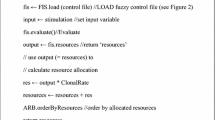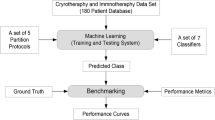Abstract
Tuberculosis is a major global health problem that has been ranked as the second leading cause of death from an infectious disease worldwide, after the human immunodeficiency virus. Diagnosis based on cultured specimens is the reference standard; however, results take weeks to obtain. Slow and insensitive diagnostic methods hampered the global control of tuberculosis, and scientists are looking for early detection strategies, which remain the foundation of tuberculosis control. Consequently, there is a need to develop an expert system that helps medical professionals to accurately diagnose the disease. The objective of this study is to diagnose tuberculosis using a machine learning method. Artificial immune recognition system (AIRS) has been used successfully for diagnosing various diseases. However, little effort has been undertaken to improve its classification accuracy. In order to increase the classification accuracy, this study introduces a new hybrid system that incorporates real tournament selection mechanism into the AIRS. This mechanism is used to control the population size of the model and to overcome the existing selection pressure. Patient epacris reports obtained from the Pasteur laboratory in northern Iran were used as the benchmark data set. The sample consisted of 175 records, from which 114 (65 %) were positive for TB, and the remaining 61 (35 %) were negative. The classification performance was measured through tenfold cross-validation, root-mean-square error, sensitivity, and specificity. With an accuracy of 100 %, RMSE of 0, sensitivity of 100 %, and specificity of 100 %, the proposed method was able to successfully classify tuberculosis cases. In addition, the proposed method is comparable with top classifiers used in this research.





Similar content being viewed by others
References
Ahn CW (2006) Advances in evolutionary algorithms: theory, design and practice. Springer, Heidelberg
Bird L (2010) Infectious disease: the tuberculosis signature. Nat Rev Immunol 10:677
Boehme CC, Nabeta P, Hillemann D, Nicol MP, Shenai S, Krapp F et al (2010) Rapid molecular detection of tuberculosis and rifampin resistance. N Engl J Med 363:1005–1015
Brownlee J (2005) Artificial immune recognition system (airs)-a review and analysis. Swinburne University of Technology, Melbourne
Brownlee J (2011) Clever algorithms: nature-inspired programming recipes, 1st edn. Lulu Enterprises, Raleigh
Chen CH, Xu C, Bie RF, Gao XZ (2008) Artificial immune recognition system for DNA microarray data analysis. In: Guo MZ, Zhao L, Wang LP (ed) Fourth international conference on natural computation: Icnc. pp 633–677
Chiang CY, Van Weezenbeek C, Mori T, Enarson DA (2013) Challenges to the global control of tuberculosis. Respirology 18:596–604
Chikh MA, Saidi M, Settouti N (2012) Diagnosis of diabetes diseases using an artificial immune recognition system2 (airs2) with fuzzy k-nearest neighbor. J Med Syst 36:2721–2729
Cios KJ, William Moore G (2002) Uniqueness of medical data mining. Artif Intell Med 26:1–24
Clark WR (2007) In defense of self how the immune system really works. Oxford University Press, New York
Cuevas E, Osuna-Enciso V, Zaldivar D, Pérez-Cisneros M, Sossa H (2012) Multithreshold segmentation based on artificial immune systems. Math Probl Eng 2012:2020
Dasgupta D (1998) An overview of artificial immune systems and their applications from the book artificial immune system and their applications. Springer, Heidelberg
De Castro LN, Timmis J (2002) Artificial immune systems: a new computational intelligence approach. Springer, Heidelberg
DE Goodman J, Boggess L, Watkins A (2003) An investigation into the source of power for AIRS, an artificial immune classification system. International joint conference on neural networks. Portland, IEEE pp 1678–1683
Delen D, Walker G, Kadam A (2005) Predicting breast cancer survivability: a comparison of three data mining methods. Artif Intel Med 34:113–127
Forouzideh N, Mahmoudi MT, Badie K (2011) Organizational texts classification using artificial immune recognition systems. IEEE symposium on computational intelligence in bioinformatics and computational biology (CIBCB): IEEE pp 1–18
Golzari S, Doraisamy S, Sulaiman MN, Udzir NI (2009) Improving the accuracy of airs by incorporating real world tournament selection in resource competition phase. Trondheim, Norway
Golzari S, Doraisamy S, Sulaiman MN, Udzir NI (2009) Incorporation of adapted real world tournament selection into artificial immune recognition system. Studies in computational intelligence. Springer, Berlin, pp 329-334
Goodman D, Boggess L, Watkins A (2002) Artificial immune system classification of multiple-class problems. Proc Artif Neural Netw Eng ANNIE 2:179–183
Hall M, Frank E, Holmes G, Pfahringer B, Reutemann P, Witten IH (2009) The WEKA data mining Software: an update. SIGKDD explorations
Hamaker JS, Boggess L (2004) Non-euclidean distance measures in AIRS, an artificial immune classification system. IEEE vol 1. pp 1067–1073
Huang Y-H, Ko Y-C, Lu H-C (2012) An optimal classification method for biological and medical data. Math Probl Eng 2012:2017
Jenhani I, Elouedi Z (2012) Re-visiting the artificial immune recognition system: a survey and an improved version. Artif Intell Rev 1–13
Kahramanli H, Allahverdi N (2008) Design of a hybrid system for the diabetes and heart diseases. Expert Syst Appl 35:82–89
Kara S, Aksebzeci BH, Kodaz H, Güneş S, Kaya E, Ozbilge H (2009) Medical application of information gain-based artificial immune recognition system (IG-AIRS): classification of microorganism species. Expert Sys Appl 36:5168–5172
Kodaz H, Babaoğlu İ, İşcan H (2009) Thyroid disease diagnosis using artificial immune recognition system (AIRS). Proceedings of the 2nd international conference on interaction sciences: information technology, culture and human: ACM. pp 756–761
Kugelberg E (2014) Immune evasion: mycobacteria hide from TLRs. Nat Rev Immunol 14:62–63
Latifoǧlu F, Kodaz H, Kara S, Güneş S (2007) Medical application of artificial immune recognition system (AIRS): diagnosis of atherosclerosis from carotid artery Doppler signals. Comput Biol Med 37:1092–1099
Le X, Mo-Yuen C (2008) Distribution fault diagnosis using a hybrid algorithm of fuzzy classification and artificial immune systems. Power and energy society general meeting—conversion and delivery of electrical energy in the 21st century, IEEE2008. pp 1266-1271
Lee S, Soak S, Kim K, Park H, Jeon M (2008) Statistical properties analysis of real world tournament selection in genetic algorithms. Appl Intel 28:195–205
Lienhardt C, Glaziou P, Uplekar M, Lönnroth K (2012) Global tuberculosis control: lessons learnt and future prospects. Nat Rev Microbiol 10:407–416
Lienhardt C, Glaziou P, Uplekar M, Lönnroth K, Getahun H, Raviglione M (2012) Global tuberculosis control: lessons learnt and future prospects. Nat Rev Microbiol 10:407–416
Lin HC, Su CT, Wang PC (2011) An application of artificial immune recognition system for prediction of diabetes following gestational diabetes. J Med Syst 35:283–289
Marwah G, Boggess L (2002) Artificial immune systems for classification: some issues. University of kent at Canterbury, Citeseer, pp 149–153
Meng L, van der Putten P, Wang HA (2005) comprehensive benchmark of the artificial immune recognition system (AIRS). Advanced data mining and applications 729
Miller BL, Goldberg DE (1995) Genetic algorithms, tournament selection, and the effects of noise. Urbana 51:61801
Wikipedia. artificial immune system. Wikipedia.org; 2012. p. Definition and history of artificial immune system
Organization WH. Global tuberculosis report 2013: World Health Organization; 2013
Pendharkar P, Rodger J, Yaverbaum G, Herman N, Benner M (1999) Association, statistical, mathematical and neural approaches for mining breast cancer patterns. Expert Syst Appl 17:223–232
Polat K, Güneş S (2008) Artificial immune recognition system with fuzzy resource allocation mechanism classifier, principal component analysis and FFT method based new hybrid automated identification system for classification of EEG signals. Expert Syst Appl 34:2039–2048
Polat K, Güneş S, Tosun S (2006) Diagnosis of heart disease using artificial immune recognition system and fuzzy weighted pre-processing. Pattern Recognit 39:2186–2193
Polat K, Şahan S, Kodaz H, Güneş S (2007) Breast cancer and liver disorders classification using artificial immune recognition system (AIRS) with performance evaluation by fuzzy resource allocation mechanism. Expert Syst Appl 32:172–183
Polat K, Şahan S, Güneş S (2007) A novel hybrid method based on artificial immune recognition system (AIRS) with fuzzy weighted pre-processing for thyroid disease diagnosis. Expert Syst Appl 32:1141–1147
Rodwell TC, Valafar F, Douglas J, Qian L, Garfein RS, Chawla A et al (2014) Predicting extensively drug-resistant Mycobacterium tuberculosis phenotypes with genetic mutations. J Clin Microbiol 52:781–789
Saidi M, Chikh MA, Settouti N (2012) Automatic identification of diabetes diseases using a modified artificial immune recognition system2 (MAIRS2). CEUR-WS.org via Sun SITE Central Europe
Saybani MR, Shamshirband S, Golzari Hormozi S, Wah TY, Aghabozorgi S, Pourhoseingholi MA et al (2015) Diagnosing tuberculosis with a novel support vector machine-based artificial immune recognition system. Iran Red Crescent Med J 17:e24557
Shamshirband S, Hessam S, Javidnia H, Amiribesheli M, Vahdat S, Petković D et al (2014) Tuberculosis disease diagnosis using artificial immune recognition system. Int J Med Sci 11:508
Sompayrac L (2012) How the immune system works. Wiley, Chichester
Timmis J, Neal M (2001) A resource limited artificial immune system for data analysis. Knowl-Based Syst 14:121–130
Timmis J, Knight T, De Castro LN, Hart E (2004) An overview of artificial immune systems
Travers P, Walport MJ, Janeway C, Murphy KP (2008) Janeway’s immunobiology. Garland Science, New York
Tunç T (2012) A new hybrid method logistic regression and feedforward neural network for lung cancer data. Mathematical problems in engineering
Van Deun A, Maug AKJ, Salim MAH, Das PK, Sarker MR, Daru P et al (2010) Short, highly effective, and inexpensive standardized treatment of multidrug-resistant tuberculosis. Am J Respir Crit Care Med 182:684–692
Watkins A (2001) AIRS: a resource limited artificial immune classifier. Mississipi State University, Mississipi
Watkins A, Boggess L (2002) A resource limited artificial immune classifier. Congress on evolutionary computation. Hawaii: IEEE. pp 926–931
Watkins A, Boggess L (2002) A new classifier based on resource limited artificial immune systems. World congress on computational intelligence Honolulu, pp 1546–1551
Watkins A, Timmis J (2012) Artificial immune recognition system (AIRS): revisions and refinements. 1st International conference on artificial immune systems. University of Kent at Canterbury, UK: University of Kent at Canterbury Printing Unit; pp 173–181
Witten IH, Frank E, Hall MA (2011) Data mining practical machine learning tools and techniques, 3rd edn. Morgan Kaufmann Publishers, Burlington
Acknowledgments
This work is supported by University of Malaya Research Grant no vote RP0061–13ICT.
Conflict of interest
The authors declare that there is no conflict of interests regarding the publication of this paper.
Author information
Authors and Affiliations
Corresponding authors
Rights and permissions
About this article
Cite this article
Saybani, M.R., Shamshirband, S., Golzari, S. et al. RAIRS2 a new expert system for diagnosing tuberculosis with real-world tournament selection mechanism inside artificial immune recognition system. Med Biol Eng Comput 54, 385–399 (2016). https://doi.org/10.1007/s11517-015-1323-6
Received:
Accepted:
Published:
Issue Date:
DOI: https://doi.org/10.1007/s11517-015-1323-6




